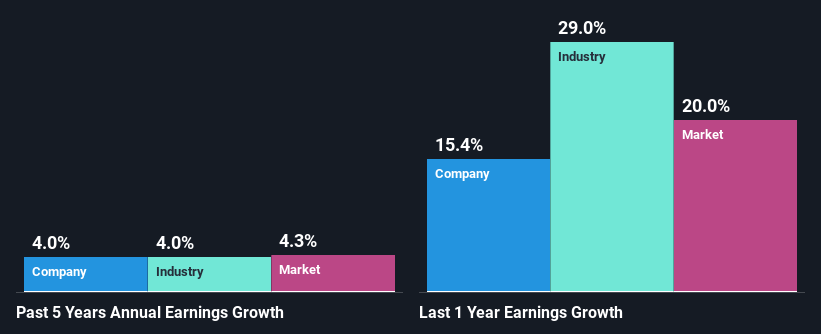Port of Tauranga Limited's (NZSE:POT) Dismal Stock Performance Reflects Weak Fundamentals
Port of Tauranga (NZSE:POT) has had a rough three months with its share price down 4.8%. To decide if this trend could continue, we decided to look at its weak fundamentals as they shape the long-term market trends. Specifically, we decided to study Port of Tauranga's ROE in this article.
Return on equity or ROE is an important factor to be considered by a shareholder because it tells them how effectively their capital is being reinvested. In short, ROE shows the profit each dollar generates with respect to its shareholder investments.
See our latest analysis for Port of Tauranga
How Do You Calculate Return On Equity?
The formula for ROE is:
Return on Equity = Net Profit (from continuing operations) ÷ Shareholders' Equity
So, based on the above formula, the ROE for Port of Tauranga is:
7.3% = NZ$102m ÷ NZ$1.4b (Based on the trailing twelve months to June 2021).
The 'return' is the profit over the last twelve months. So, this means that for every NZ$1 of its shareholder's investments, the company generates a profit of NZ$0.07.
What Has ROE Got To Do With Earnings Growth?
We have already established that ROE serves as an efficient profit-generating gauge for a company's future earnings. We now need to evaluate how much profit the company reinvests or "retains" for future growth which then gives us an idea about the growth potential of the company. Assuming all else is equal, companies that have both a higher return on equity and higher profit retention are usually the ones that have a higher growth rate when compared to companies that don't have the same features.
Port of Tauranga's Earnings Growth And 7.3% ROE
At first glance, Port of Tauranga's ROE doesn't look very promising. Yet, a closer study shows that the company's ROE is similar to the industry average of 7.3%. Having said that, Port of Tauranga has shown a meagre net income growth of 4.0% over the past five years. Remember, the company's ROE is not particularly great to begin with. So this could also be one of the reasons behind the company's low growth in earnings.
We then performed a comparison between Port of Tauranga's net income growth with the industry, which revealed that the company's growth is similar to the average industry growth of 4.0% in the same period.
Earnings growth is a huge factor in stock valuation. It’s important for an investor to know whether the market has priced in the company's expected earnings growth (or decline). Doing so will help them establish if the stock's future looks promising or ominous. If you're wondering about Port of Tauranga's's valuation, check out this gauge of its price-to-earnings ratio, as compared to its industry.
Is Port of Tauranga Making Efficient Use Of Its Profits?
With a high three-year median payout ratio of 90% (or a retention ratio of 9.5%), most of Port of Tauranga's profits are being paid to shareholders. This definitely contributes to the low earnings growth seen by the company.
In addition, Port of Tauranga has been paying dividends over a period of at least ten years suggesting that keeping up dividend payments is way more important to the management even if it comes at the cost of business growth. Upon studying the latest analysts' consensus data, we found that the company is expected to keep paying out approximately 87% of its profits over the next three years. Accordingly, forecasts suggest that Port of Tauranga's future ROE will be 8.7% which is again, similar to the current ROE.
Conclusion
On the whole, Port of Tauranga's performance is quite a big let-down. While no doubt its earnings growth is pretty respectable, its ROE and earnings retention is quite poor. So while the company has managed to grow its earnings in spite of this, we are unconvinced if this growth could extend, specially during troubled times. Having said that, looking at the current analyst estimates, we found that the company's earnings are expected to gain momentum. To know more about the latest analysts predictions for the company, check out this visualization of analyst forecasts for the company.
This article by Simply Wall St is general in nature. We provide commentary based on historical data and analyst forecasts only using an unbiased methodology and our articles are not intended to be financial advice. It does not constitute a recommendation to buy or sell any stock, and does not take account of your objectives, or your financial situation. We aim to bring you long-term focused analysis driven by fundamental data. Note that our analysis may not factor in the latest price-sensitive company announcements or qualitative material. Simply Wall St has no position in any stocks mentioned.
Have feedback on this article? Concerned about the content? Get in touch with us directly. Alternatively, email editorial-team (at) simplywallst.com.

 Yahoo Finance
Yahoo Finance 
